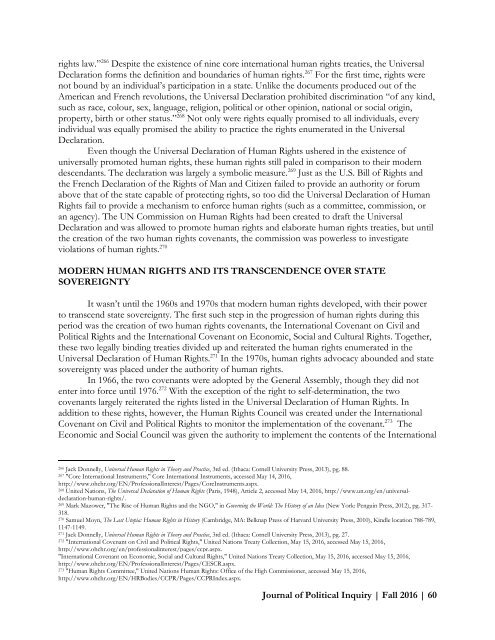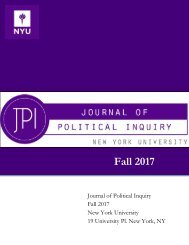Fall2016_Final
You also want an ePaper? Increase the reach of your titles
YUMPU automatically turns print PDFs into web optimized ePapers that Google loves.
ights law.” 266 Despite the existence of nine core international human rights treaties, the Universal<br />
Declaration forms the definition and boundaries of human rights. 267 For the first time, rights were<br />
not bound by an individual’s participation in a state. Unlike the documents produced out of the<br />
American and French revolutions, the Universal Declaration prohibited discrimination “of any kind,<br />
such as race, colour, sex, language, religion, political or other opinion, national or social origin,<br />
property, birth or other status.” 268 Not only were rights equally promised to all individuals, every<br />
individual was equally promised the ability to practice the rights enumerated in the Universal<br />
Declaration.<br />
Even though the Universal Declaration of Human Rights ushered in the existence of<br />
universally promoted human rights, these human rights still paled in comparison to their modern<br />
descendants. The declaration was largely a symbolic measure. 269 Just as the U.S. Bill of Rights and<br />
the French Declaration of the Rights of Man and Citizen failed to provide an authority or forum<br />
above that of the state capable of protecting rights, so too did the Universal Declaration of Human<br />
Rights fail to provide a mechanism to enforce human rights (such as a committee, commission, or<br />
an agency). The UN Commission on Human Rights had been created to draft the Universal<br />
Declaration and was allowed to promote human rights and elaborate human rights treaties, but until<br />
the creation of the two human rights covenants, the commission was powerless to investigate<br />
violations of human rights. 270<br />
MODERN HUMAN RIGHTS AND ITS TRANSCENDENCE OVER STATE<br />
SOVEREIGNTY<br />
It wasn’t until the 1960s and 1970s that modern human rights developed, with their power<br />
to transcend state sovereignty. The first such step in the progression of human rights during this<br />
period was the creation of two human rights covenants, the International Covenant on Civil and<br />
Political Rights and the International Covenant on Economic, Social and Cultural Rights. Together,<br />
these two legally binding treaties divided up and reiterated the human rights enumerated in the<br />
Universal Declaration of Human Rights. 271 In the 1970s, human rights advocacy abounded and state<br />
sovereignty was placed under the authority of human rights.<br />
In 1966, the two covenants were adopted by the General Assembly, though they did not<br />
enter into force until 1976. 272 With the exception of the right to self-determination, the two<br />
covenants largely reiterated the rights listed in the Universal Declaration of Human Rights. In<br />
addition to these rights, however, the Human Rights Council was created under the International<br />
Covenant on Civil and Political Rights to monitor the implementation of the covenant. 273 The<br />
Economic and Social Council was given the authority to implement the contents of the International<br />
266<br />
Jack Donnelly, Universal Human Rights in Theory and Practice, 3rd ed. (Ithaca: Cornell University Press, 2013), pg. 88.<br />
267<br />
"Core International Instruments," Core International Instruments, accessed May 14, 2016,<br />
http://www.ohchr.org/EN/ProfessionalInterest/Pages/CoreInstruments.aspx.<br />
268<br />
United Nations, The Universal Declaration of Human Rights (Paris, 1948), Article 2, accessed May 14, 2016, http://www.un.org/en/universaldeclaration-human-rights/.<br />
269<br />
Mark Mazower, "The Rise of Human Rights and the NGO," in Governing the World: The History of an Idea (New York: Penguin Press, 2012), pg. 317-<br />
318.<br />
270<br />
Samuel Moyn, The Last Utopia: Human Rights in History (Cambridge, MA: Belknap Press of Harvard University Press, 2010), Kindle location 788-789,<br />
1147-1149.<br />
271<br />
Jack Donnelly, Universal Human Rights in Theory and Practice, 3rd ed. (Ithaca: Cornell University Press, 2013), pg. 27.<br />
272<br />
"International Covenant on Civil and Political Rights," United Nations Treaty Collection, May 15, 2016, accessed May 15, 2016,<br />
http://www.ohchr.org/en/professionalinterest/pages/ccpr.aspx.<br />
"International Covenant on Economic, Social and Cultural Rights," United Nations Treaty Collection, May 15, 2016, accessed May 15, 2016,<br />
http://www.ohchr.org/EN/ProfessionalInterest/Pages/CESCR.aspx.<br />
273<br />
"Human Rights Committee," United Nations Human Rights: Office of the High Commissioner, accessed May 15, 2016,<br />
http://www.ohchr.org/EN/HRBodies/CCPR/Pages/CCPRIndex.aspx.<br />
Journal of Political Inquiry | Fall 2016 | 60
















